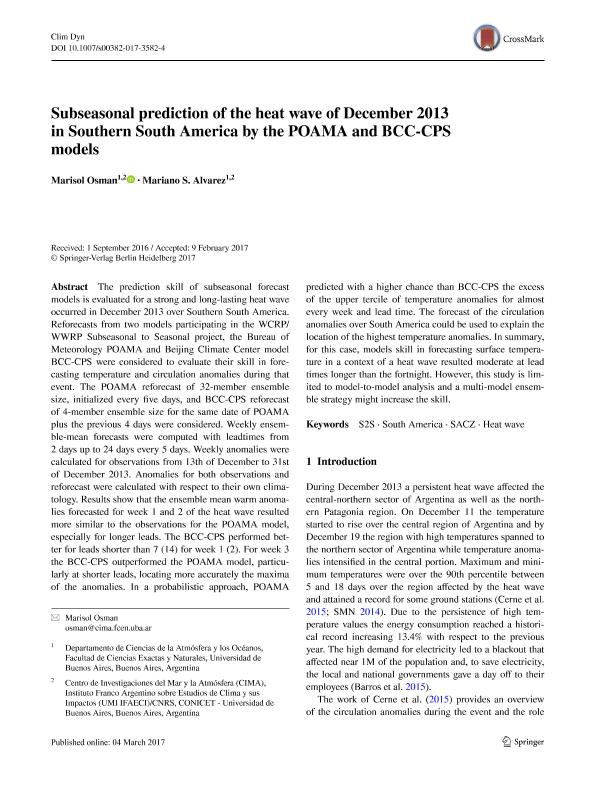Mostrar el registro sencillo del ítem
dc.contributor.author
Osman, Marisol

dc.contributor.author
Alvarez, Mariano Sebastián

dc.date.available
2018-09-07T18:42:53Z
dc.date.issued
2018-01
dc.identifier.citation
Osman, Marisol; Alvarez, Mariano Sebastián; Subseasonal prediction of the heat wave of December 2013 in Southern South America by the POAMA and BCC-CPS models; Springer; Climate Dynamics; 50; 1-2; 1-2018; 67-81
dc.identifier.issn
0930-7575
dc.identifier.uri
http://hdl.handle.net/11336/58776
dc.description.abstract
The prediction skill of subseasonal forecast models is evaluated for a strong and long-lasting heat wave occurred in December 2013 over Southern South America. Reforecasts from two models participating in the WCRP/WWRP Subseasonal to Seasonal project, the Bureau of Meteorology POAMA and Beijing Climate Center model BCC-CPS were considered to evaluate their skill in forecasting temperature and circulation anomalies during that event. The POAMA reforecast of 32-member ensemble size, initialized every five days, and BCC-CPS reforecast of 4-member ensemble size for the same date of POAMA plus the previous 4 days were considered. Weekly ensemble-mean forecasts were computed with leadtimes from 2 days up to 24 days every 5 days. Weekly anomalies were calculated for observations from 13th of December to 31st of December 2013. Anomalies for both observations and reforecast were calculated with respect to their own climatology. Results show that the ensemble mean warm anomalies forecasted for week 1 and 2 of the heat wave resulted more similar to the observations for the POAMA model, especially for longer leads. The BCC-CPS performed better for leads shorter than 7 (14) for week 1 (2). For week 3 the BCC-CPS outperformed the POAMA model, particularly at shorter leads, locating more accurately the maxima of the anomalies. In a probabilistic approach, POAMA predicted with a higher chance than BCC-CPS the excess of the upper tercile of temperature anomalies for almost every week and lead time. The forecast of the circulation anomalies over South America could be used to explain the location of the highest temperature anomalies. In summary, for this case, models skill in forecasting surface temperature in a context of a heat wave resulted moderate at lead times longer than the fortnight. However, this study is limited to model-to-model analysis and a multi-model ensemble strategy might increase the skill.
dc.format
application/pdf
dc.language.iso
eng
dc.publisher
Springer

dc.rights
info:eu-repo/semantics/openAccess
dc.rights.uri
https://creativecommons.org/licenses/by-nc-sa/2.5/ar/
dc.subject
Heat Wave
dc.subject
S2s
dc.subject
Sacz
dc.subject
South America
dc.subject.classification
Meteorología y Ciencias Atmosféricas

dc.subject.classification
Ciencias de la Tierra y relacionadas con el Medio Ambiente

dc.subject.classification
CIENCIAS NATURALES Y EXACTAS

dc.title
Subseasonal prediction of the heat wave of December 2013 in Southern South America by the POAMA and BCC-CPS models
dc.type
info:eu-repo/semantics/article
dc.type
info:ar-repo/semantics/artículo
dc.type
info:eu-repo/semantics/publishedVersion
dc.date.updated
2018-09-07T13:44:02Z
dc.journal.volume
50
dc.journal.number
1-2
dc.journal.pagination
67-81
dc.journal.pais
Alemania

dc.journal.ciudad
Berlin
dc.description.fil
Fil: Osman, Marisol. Consejo Nacional de Investigaciones Científicas y Técnicas. Oficina de Coordinación Administrativa Ciudad Universitaria. Centro de Investigaciones del Mar y la Atmósfera. Universidad de Buenos Aires. Facultad de Ciencias Exactas y Naturales. Centro de Investigaciones del Mar y la Atmósfera; Argentina. Universidad de Buenos Aires. Facultad de Ciencias Exactas y Naturales. Departamento de Ciencias de la Atmósfera y los Océanos; Argentina
dc.description.fil
Fil: Alvarez, Mariano Sebastián. Consejo Nacional de Investigaciones Científicas y Técnicas. Oficina de Coordinación Administrativa Ciudad Universitaria. Centro de Investigaciones del Mar y la Atmósfera. Universidad de Buenos Aires. Facultad de Ciencias Exactas y Naturales. Centro de Investigaciones del Mar y la Atmósfera; Argentina. Universidad de Buenos Aires. Facultad de Ciencias Exactas y Naturales. Departamento de Ciencias de la Atmósfera y los Océanos; Argentina
dc.journal.title
Climate Dynamics

dc.relation.alternativeid
info:eu-repo/semantics/altIdentifier/doi/https://dx.doi.org/10.1007/s00382-017-3582-4
dc.relation.alternativeid
info:eu-repo/semantics/altIdentifier/url/https://link.springer.com/article/10.1007/s00382-017-3582-4
Archivos asociados
